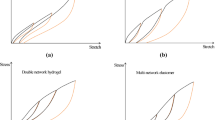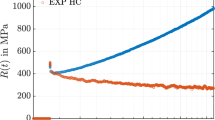Results of experimental investigations and evaluations of the influence of the microstructure of polyvinylchloride macromolecules on relaxation processes in heterogeneous systems containing nanodispersed copper powders have been given. It has been shown that the relaxation β transition whose parameters are dependent on the content of the filler in the composite is realized in the region 300 K ≤ T < 400 K. The interrelation between the β transition and the cooperative glass α transition has been established. A derivatographic analysis of the distinctive features of the process of splitting of the α maximum with allowance for the degree of ordering of the arrangement of segments in the composite volume has been made. Calculated and experimental values of the sought quantities have been compared.
Similar content being viewed by others
References
A. R. Khokhlov, Structure and properties of solid polymers, Vysokomol. Soedin. (A), 51, No. 1, 37–65 (2009).
B. B. Kolupaev, Anisotropy of thermal conductivity of ferro-filled PVC, J. Eng. Phys. Thermophys., 85, No. 3, 684–690 (2012).
U. Wandlandt, Thermal Methods of Analysis [Russian translation], Mir, Moscow (1978).
I. H. Tavman, Thermophysical properties of high temperatures, Heat Mass Transf., 25, No. 5, 723–731 (1998).
B. S. Kolupaev, Relaxation and Thermal Properties of Filled Polymer Systems [in Russian], Vishcha Shkola, L’vov (1980).
V. A. Bershtein and V. M. Egorov, Differential Scanning Calorimetry in the Physics and Chemistry of Polymers [in Russian], Khimiya, Leningrad (1990).
J. Heijboer, Static and Dynamic of the Polymeric Solid State, Reidel Publ. Co. (1982), pp. 197–211.
G. M. Bartenev and S. Ya. Frenkel’, The Physics of Polymers [in Russian], Khimiya, Leningrad (1990).
S. Yu. Davydov, On inhomogeneous charge distribution in an adsorbed layer, Fiz. Tverd. Tela, 21, No. 8, 2283–2291 (1979).
V. Bares and B. Wunderlich, Heat capacity of molten polymers, J. Polym. Sci., 11, No. 6, 1301–1318 (1973).
G. V. Kozlov and V. U. Novikov, Cluster model of amorphous state of polymers, Usp. Fiz Nauk, 171, No. 7, 717–764 (2001).
B. Wunderlich and H. Bauer, Heat Capacity of Linear Polymers [Russian translation], Mir, Moscow (1972).
Author information
Authors and Affiliations
Corresponding author
Additional information
Translated from Inzhenerno-Fizicheskii Zhurnal, Vol. 86, No. 4, pp. 801–806, July–August, 2013.
Rights and permissions
About this article
Cite this article
Sidletskii, V.A., Kolupaev, B.B., Klepko, V.V. et al. Relaxation transitions in polyvinylchloride containing a nanodispersed material. J Eng Phys Thermophy 86, 856–862 (2013). https://doi.org/10.1007/s10891-013-0904-1
Received:
Published:
Issue Date:
DOI: https://doi.org/10.1007/s10891-013-0904-1




